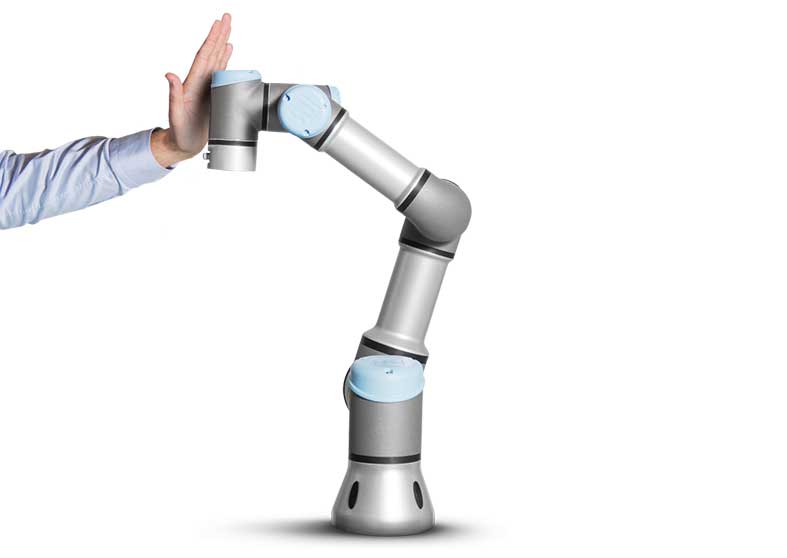TECHNOLOGY
How a Cobot Collaborates with Humans for Maximum Yield

Automating collaboration is crucial to improving safety, productivity, and efficiency in the industrial world.
A cobot offers the solution as it can safely work alongside people on the factory floor, making it ideal for companies looking to automate processes and preserve their workforce. As such, they have some safety features that ensure they can operate safely in the workplace. In addition, they come with sensors that help them detect and avoid obstacles in their environment.
A cobot, a collaborative robot, works alongside humans and takes over dull, dangerous, and repetitive jobs. A cobot is an excellent solution that makes companies work faster and more accurately without replacing human workers. They need training and programming for each task to know what and how to do a specific job. They need an environment that allows them to move freely without hitting objects or people.
Features of a Cobot
Collaborative robots use force-sensing technology to detect a person nearby, allowing them to stop moving or reverse if something gets in their way. These sensors make them safer than traditional automation systems because they come without safety mechanisms like cages, safety guards, or barriers. Cobots operate within a safety envelope, monitored by sensors that detect the presence of people. The cobot will stop moving if someone gets close or touches its sides or top. Cobots can detect falling objects in their safety zone and prevent accidentally crushing them while performing the assigned task. The cobot has manipulators with arms of multiple joints that allow them to move objects around safely while avoiding contact with humans and other things in their proximity.
Collaborative Benefits of Cobot

Collaborative robots work with humans on the same line, performing different tasks as part of an integrated system or assembly line. They work side by side with humans and do not require a dedicated operator because of their ability to detect obstacles and avoid them when performing their tasks. Collaborative robotics technology combines the benefits of human operators with the advantages of robot automation. This technology has applications in many sectors, including education, manufacturing, and healthcare.
Safe to Work with Humans
A cobot works close to humans, and you can deploy it in various applications. They are easy to use and do not require any programming knowledge. For example, a cobot in an assembly line follows a specific path at speed safe for humans. Collaborative robots have built-in safety features to protect operators and enable them to avoid obstacles and prevent injuries arising out of human error.
Easy Integration into Existing Processes
Companies can purchase more than one unit and deploy them throughout the production line at various stages where they are needed most. They can perform tasks such as picking up objects or passing tools between people on opposite sides of a machine. Cobots help in more complex functions like loading parts onto an assembly line or inspecting products after production.
Fast Production
The benefits of a collaborative robot are many, but the most significant is the speed at which you can get your product to the market. Once an order has arrived, a collaborative robot will begin working on it immediately, and you will not have to wait for weeks or months before your order is ready.
Cost Savings
Collaborative robots are relatively inexpensive compared to traditional industrial robots. As a result, businesses don’t have to invest as much money upfront when purchasing them. And because they’re safe enough for humans to interact with, there’s no need for expensive safety equipment like cages or guards.
Easy Programming
Collaborative robots are easily programmed and used because they don’t require extensive knowledge of operating complex machinery, unlike traditional industrial robots. In addition, many models come with touchscreen interfaces that allow those users without experience with automation systems to learn how they work quickly. Cobots can adapt to various environments, which means they can apply in multiple applications. They’re also easy to teach so that people with little to no experience with robotics can use it.
Highly Flexible
Collaborative robots can handle a wide range of tasks and can adapt to different environments without requiring any additional components or hardware. This feature enables multiple settings and applications, from manufacturing facilities to warehouses and hospitals. In addition, you don’t need extensive training or experience with robotics to use collaborative robots effectively. Their design allows for easy programming through simple hand gestures or voice commands, so you don’t need any previous knowledge about how industrial machinery works or how it should be programmed and operated.
Helpful Across Industries
Cobots excel in different industries. Collaborative robots can perform tasks in manufacturing and distribution, healthcare, food and beverage manufacturing, and more. They are an excellent option for companies looking for flexible automation solutions that will help them increase productivity while keeping costs low.
Automotive manufacturers constantly strive to innovate and improve their performance to stay ahead of their competitors. Using collaborative robots in automotive assembly lines can help automate the manufacturing process and reduce the time taken to assemble a car.
The use of collaborative robots in education is growing exponentially as more and more schools adopt the technology. Collaborative robots best apply in situations where human safety is paramount, and students can benefit from increased levels of engagement.
Assembly
Cobots are excellent for assembly work because they can handle delicate parts without damaging them or risking worker injuries. You can make them follow precise instructions for assembling complex objects like airplanes or cars without making mistakes that could cause damage or delays if done by humans.
Reducing Waste
One of the main challenges faced by manufacturers is scrap due to human error during assembly lines or other processes. Collaborative robots can consistently carry out repetitive tasks without making mistakes or wasting materials. Collaborative robots present accuracy and consistency, making them perfect for painting or welding tasks.
Wrapping Up

If you want your cobot to help your company become more efficient and productive, you must ensure it carries the right tools. For example, your cobot must have arms that can reach above its head or plenty of torque in its joints to lift heavy objects easily without damaging itself or others.
Source link
TECHNOLOGY
Next-gen chips, Amazon Q, and speedy S3

AWS re:Invent, which has been taking place from November 27 and runs to December 1, has had its usual plethora of announcements: a total of 21 at time of print.
Perhaps not surprisingly, given the huge potential impact of generative AI – ChatGPT officially turns one year old today – a lot of focus has been on the AI side for AWS’ announcements, including a major partnership inked with NVIDIA across infrastructure, software, and services.
Yet there has been plenty more announced at the Las Vegas jamboree besides. Here, CloudTech rounds up the best of the rest:
Next-generation chips
This was the other major AI-focused announcement at re:Invent: the launch of two new chips, AWS Graviton4 and AWS Trainium2, for training and running AI and machine learning (ML) models, among other customer workloads. Graviton4 shapes up against its predecessor with 30% better compute performance, 50% more cores and 75% more memory bandwidth, while Trainium2 delivers up to four times faster training than before and will be able to be deployed in EC2 UltraClusters of up to 100,000 chips.
The EC2 UltraClusters are designed to ‘deliver the highest performance, most energy efficient AI model training infrastructure in the cloud’, as AWS puts it. With it, customers will be able to train large language models in ‘a fraction of the time’, as well as double energy efficiency.
As ever, AWS offers customers who are already utilising these tools. Databricks, Epic and SAP are among the companies cited as using the new AWS-designed chips.
Zero-ETL integrations
AWS announced new Amazon Aurora PostgreSQL, Amazon DynamoDB, and Amazon Relational Database Services (Amazon RDS) for MySQL integrations with Amazon Redshift, AWS’ cloud data warehouse. The zero-ETL integrations – eliminating the need to build ETL (extract, transform, load) data pipelines – make it easier to connect and analyse transactional data across various relational and non-relational databases in Amazon Redshift.
A simple example of how zero-ETL functions can be seen is in a hypothetical company which stores transactional data – time of transaction, items bought, where the transaction occurred – in a relational database, but use another analytics tool to analyse data in a non-relational database. To connect it all up, companies would previously have to construct ETL data pipelines which are a time and money sink.
The latest integrations “build on AWS’s zero-ETL foundation… so customers can quickly and easily connect all of their data, no matter where it lives,” the company said.
Amazon S3 Express One Zone
AWS announced the general availability of Amazon S3 Express One Zone, a new storage class purpose-built for customers’ most frequently-accessed data. Data access speed is up to 10 times faster and request costs up to 50% lower than standard S3. Companies can also opt to collocate their Amazon S3 Express One Zone data in the same availability zone as their compute resources.
Companies and partners who are using Amazon S3 Express One Zone include ChaosSearch, Cloudera, and Pinterest.
Amazon Q
A new product, and an interesting pivot, again with generative AI at its core. Amazon Q was announced as a ‘new type of generative AI-powered assistant’ which can be tailored to a customer’s business. “Customers can get fast, relevant answers to pressing questions, generate content, and take actions – all informed by a customer’s information repositories, code, and enterprise systems,” AWS added. The service also can assist companies building on AWS, as well as companies using AWS applications for business intelligence, contact centres, and supply chain management.
Customers cited as early adopters include Accenture, BMW and Wunderkind.
Want to learn more about cybersecurity and the cloud from industry leaders? Check out Cyber Security & Cloud Expo taking place in Amsterdam, California, and London. Explore other upcoming enterprise technology events and webinars powered by TechForge here.
TECHNOLOGY
HCLTech and Cisco create collaborative hybrid workplaces

Digital comms specialist Cisco and global tech firm HCLTech have teamed up to launch Meeting-Rooms-as-a-Service (MRaaS).
Available on a subscription model, this solution modernises legacy meeting rooms and enables users to join meetings from any meeting solution provider using Webex devices.
The MRaaS solution helps enterprises simplify the design, implementation and maintenance of integrated meeting rooms, enabling seamless collaboration for their globally distributed hybrid workforces.
Rakshit Ghura, senior VP and Global head of digital workplace services, HCLTech, said: “MRaaS combines our consulting and managed services expertise with Cisco’s proficiency in Webex devices to change the way employees conceptualise, organise and interact in a collaborative environment for a modern hybrid work model.
“The common vision of our partnership is to elevate the collaboration experience at work and drive productivity through modern meeting rooms.”
Alexandra Zagury, VP of partner managed and as-a-Service Sales at Cisco, said: “Our partnership with HCLTech helps our clients transform their offices through cost-effective managed services that support the ongoing evolution of workspaces.
“As we reimagine the modern office, we are making it easier to support collaboration and productivity among workers, whether they are in the office or elsewhere.”
Cisco’s Webex collaboration devices harness the power of artificial intelligence to offer intuitive, seamless collaboration experiences, enabling meeting rooms with smart features such as meeting zones, intelligent people framing, optimised attendee audio and background noise removal, among others.
Want to learn more about cybersecurity and the cloud from industry leaders? Check out Cyber Security & Cloud Expo taking place in Amsterdam, California, and London. Explore other upcoming enterprise technology events and webinars powered by TechForge here.
TECHNOLOGY
Canonical releases low-touch private cloud MicroCloud

Canonical has announced the general availability of MicroCloud, a low-touch, open source cloud solution. MicroCloud is part of Canonical’s growing cloud infrastructure portfolio.
It is purpose-built for scalable clusters and edge deployments for all types of enterprises. It is designed with simplicity, security and automation in mind, minimising the time and effort to both deploy and maintain it. Conveniently, enterprise support for MicroCloud is offered as part of Canonical’s Ubuntu Pro subscription, with several support tiers available, and priced per node.
MicroClouds are optimised for repeatable and reliable remote deployments. A single command initiates the orchestration and clustering of various components with minimal involvement by the user, resulting in a fully functional cloud within minutes. This simplified deployment process significantly reduces the barrier to entry, putting a production-grade cloud at everyone’s fingertips.
Juan Manuel Ventura, head of architectures & technologies at Spindox, said: “Cloud computing is not only about technology, it’s the beating heart of any modern industrial transformation, driving agility and innovation. Our mission is to provide our customers with the most effective ways to innovate and bring value; having a complexity-free cloud infrastructure is one important piece of that puzzle. With MicroCloud, the focus shifts away from struggling with cloud operations to solving real business challenges” says
In addition to seamless deployment, MicroCloud prioritises security and ease of maintenance. All MicroCloud components are built with strict confinement for increased security, with over-the-air transactional updates that preserve data and roll back on errors automatically. Upgrades to newer versions are handled automatically and without downtime, with the mechanisms to hold or schedule them as needed.
With this approach, MicroCloud caters to both on-premise clouds but also edge deployments at remote locations, allowing organisations to use the same infrastructure primitives and services wherever they are needed. It is suitable for business-in-branch office locations or industrial use inside a factory, as well as distributed locations where the focus is on replicability and unattended operations.
Cedric Gegout, VP of product at Canonical, said: “As data becomes more distributed, the infrastructure has to follow. Cloud computing is now distributed, spanning across data centres, far and near edge computing appliances. MicroCloud is our answer to that.
“By packaging known infrastructure primitives in a portable and unattended way, we are delivering a simpler, more prescriptive cloud experience that makes zero-ops a reality for many Industries.“
MicroCloud’s lightweight architecture makes it usable on both commodity and high-end hardware, with several ways to further reduce its footprint depending on your workload needs. In addition to the standard Ubuntu Server or Desktop, MicroClouds can be run on Ubuntu Core – a lightweight OS optimised for the edge. With Ubuntu Core, MicroClouds are a perfect solution for far-edge locations with limited computing capabilities. Users can choose to run their workloads using Kubernetes or via system containers. System containers based on LXD behave similarly to traditional VMs but consume fewer resources while providing bare-metal performance.
Coupled with Canonical’s Ubuntu Pro + Support subscription, MicroCloud users can benefit from an enterprise-grade open source cloud solution that is fully supported and with better economics. An Ubuntu Pro subscription offers security maintenance for the broadest collection of open-source software available from a single vendor today. It covers over 30k packages with a consistent security maintenance commitment, and additional features such as kernel livepatch, systems management at scale, certified compliance and hardening profiles enabling easy adoption for enterprises. With per-node pricing and no hidden fees, customers can rest assured that their environment is secure and supported without the expensive price tag typically associated with cloud solutions.
Want to learn more about cybersecurity and the cloud from industry leaders? Check out Cyber Security & Cloud Expo taking place in Amsterdam, California, and London. Explore other upcoming enterprise technology events and webinars powered by TechForge here.
-

 WORDPRESS6 days ago
WORDPRESS6 days ago10 WordPress Influencers to Follow in 2024 – WordPress.com News
-

 SEARCHENGINES7 days ago
SEARCHENGINES7 days agoGoogle Image Search Adds Pixel Level Object Segmentation Animation
-

 MARKETING7 days ago
MARKETING7 days agoFeeling Stuck: What to Do When You Don’t Know What to Do
-

 PPC5 days ago
PPC5 days agoA History of Google AdWords and Google Ads: Revolutionizing Digital Advertising & Marketing Since 2000
-

 SEARCHENGINES6 days ago
SEARCHENGINES6 days agoMore Google March 2024 Core Update Ranking Volatility
-

 PPC6 days ago
PPC6 days agoCompetitor Monitoring: 7 ways to keep watch on the competition
-

 PPC5 days ago
PPC5 days ago31 Ready-to-Go Mother’s Day Messages for Social Media, Email, & More
-

 WORDPRESS6 days ago
WORDPRESS6 days agoThrive Architect vs Divi vs Elementor















You must be logged in to post a comment Login